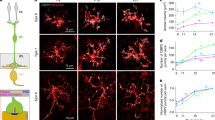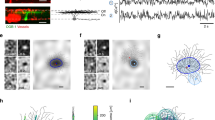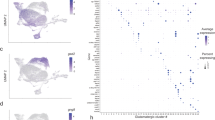Abstract
In cultures of hippocampal neurons, induction of long-term synaptic potentiation or depression by repetitive synaptic activity is accompanied by a retrograde spread of potentiation or depression, respectively, from the site of induction at the axonal outputs to the input synapses on the dendrites of the presynaptic neuron1,2. We report here that rapid retrograde synaptic modification also exists in an intact developing retinotectal system. Local application of brain-derived neurotrophic factor (BDNF) to the Xenopus laevis optic tectum, which induced persistent potentiation of retinotectal synapses, led to a rapid modification of synaptic inputs at the dendrites of retinal ganglion cells (RGCs), as shown by a persistent enhancement of light-evoked excitatory synaptic currents and spiking activity of RGCs. This retrograde effect required TrkB receptor activation, phospholipase Cγ activity and Ca2+ elevation in RGCs, and was accounted for by a selective increase in the number of postsynaptic AMPA-subtype glutamate receptors at RGC dendrites. Such retrograde information flow in the neuron allows rapid regulation of synaptic inputs at the dendrite in accordance to signals received at axon terminals, a process reminiscent of back-propagation algorithm for learning in neural networks3.
This is a preview of subscription content, access via your institution
Access options
Subscribe to this journal
Receive 51 print issues and online access
$199.00 per year
only $3.90 per issue
Buy this article
- Purchase on Springer Link
- Instant access to full article PDF
Prices may be subject to local taxes which are calculated during checkout




Similar content being viewed by others
References
Fitzsimonds, R. M., Song, H. J. & Poo, M. M. Propagation of activity-dependent synaptic depression in simple neural networks. Nature 388, 439–448 (1997)
Tao, H. W., Zhang, L. I., Bi, G. Q. & Poo, M. Selective presynaptic propagation of long-term potentiation in defined neural networks. J. Neurosci. 20, 3233–3243 (2000)
Rumelhart, D. E., Hinton, G. E. & Williams, R. J. Learning representations by back-propagation errors. Nature 323, 533–536 (1986)
Cohen-cory, S. & Fraser, S. E. BDNF in the development of the visual system of Xenopus. Neuron 12, 747–761 (1994)
Huang, E. J. & Reichardt, L. F. Neurotrophins: roles in neuronal development and function. Annu. Rev. Neurosci. 24, 677–736 (2001)
Lohof, A. M. & Poo, M. M. Potentiation of developing neuromuscular synapses by the neurotrophins NT3 and BDNF. Nature 363, 350–353 (1993)
Lessmann, V., Gottmann, K. & Heumann, R. BDNF and NT-4/5 enhance glutamatergic synaptic transmission in cultured hippocampal neurones. Neuroreport 6, 21–25 (1994)
Li, Y. X. et al. Expression of a dominant negative TrkB receptor, T1, reveals a requirement for presynaptic signaling in BDNF-induced synaptic potentiation in cultured hippocampal neurons. Proc. Natl Acad. Sci. USA 95, 10884–10889 (1998)
Schinder, A. F., Berninger, B. & Poo, M. M. Postsynaptic target specificity of neurotrophin-induced presynaptic potentiation. Neuron 25, 151–163 (2000)
Poo, M. M. Neurotrophins as synaptic modulators. Nature Rev. Neurosci. 2, 24–32 (2001)
Isaac, J. T., Nicoll, R. A. & Malenka, R. C. Evidence for silent synapses: implications for the expression of LTP. Neuron 15, 427–434 (1995)
Durand, G. M., Kovalchuk, Y. & Konnerth, A. Long-term potentiation and functional synapse induction in developing hippocampus. Nature 381, 71–75 (1996)
Wu, G. Y., Malinow, R. & Cline, H. T. Maturation of a central glutamatergic synapse. Science 274, 972–976 (1996)
Watson, F. L. et al. Rapid nuclear responses to target-derived neurotrophins require retrograde transport of ligand-receptor complex. J. Neurosci. 19, 7889–7900 (1999)
von Bartheld, C. S., Byers, M. R., Williams, R. & Bothwell, M. Anterograde transport of neurotrophins and axodendritic transfer in the developing visual system. Nature 379, 830–833 (1996)
Ginty, D. D. & Segal, R. A. Retrograde neurotrophin signaling: Trk-ing along the axon. Curr. Opin. Neurobiol. 12, 268–274 (2002)
Purves, D. Functional and structural changes in mammalian sympathetic neurons following interruption of their axons. J. Physiol. (Lond.) 252, 429–463 (1975)
Purves, D. Effects of nerve growth factor on synaptic depression after axotomy. Nature 260, 535–536 (1976)
Wong, W. T., Faulkner-Jones, B. E., Sanes, J. R. & Wong, R. O. Rapid dendritic remodeling in the developing retina: dependence on neurotransmission and reciprocal regulation by Rac and Rho. J. Neurosci. 20, 5024–5036 (2000)
Lom, B., Cogen, J., Sanchez, A. L., Vu, T. & Cohen-cory, S. Local and target-derived brain-derived neurotrophic factor exert opposing effects on the dendritic arborization of retinal ganglion cells in vivo. J. Neurosci. 22, 7639–7649 (2002)
Hartmann, M., Heumann, R. & Lessmann, V. Synaptic secretion of BDNF after high-frequency stimulation of glutamatergic synapses. EMBO J. 20, 5887–5897 (2001)
Balkowiec, A. & Katz, D. M. Cellular mechanisms regulating activity-dependent release of native brain-derived neurotrophic factor from hippocampal neurons. J. Neurosci. 22, 10399–10407 (2002)
Chytrova, G. & Johnson, J. E. Spontaneous retinal activity modulates BDNF trafficking in the developing chick visual system. Mol. Cell. Neurosci. 25, 549–557 (2004)
Constantine-Paton, M., Cline, H. T. & Debski, E. Patterned activity, synaptic convergence, and the NMDA receptor in developing visual pathways. Annu. Rev. Neurosci. 13, 129–154 (1990)
Wingate, R. J. & Thompson, I. D. Targeting and activity-related dendritic modification in mammalian retinal ganglion cells. J. Neurosci. 14, 6621–6637 (1994)
Churchland, P. S. & Sejnowski, T. J. The Computational Brain (MIT Press, Cambridge, Massachusetts, 1992)
Nieuwkoop, P. D. & Faber, J. Normal table of Xenopus laevis, 2nd edn (North Holland, Amsterdam, 1967)
Zhang, L. I., Tao, H. W., Holt, C. E., Harris, W. A. & Poo, M. M. A critical window for cooperation and competition among developing retinotectal synapses. Nature 395, 37–44 (1998)
Traynelis, S. F., Silver, R. A. & Cull-Candy, S. G. Estimated conductance of glutamate receptor channels activated during EPSCs at the cerebellar mossy fiber-granule cell synapse. Neuron 11, 279–289 (1993)
Benke, T. A., Lüthi, A., Isaac, J. T. R. & Collingridge, G. L. Modulation of AMPA receptor unitary conductance by synaptic activity. Nature 393, 793–797 (1998)
Acknowledgements
We thank X. H. Zhang for writing the software of light stimulation and Z. R. Wang for establishing the method of TrkB knockdown of Xenopus tadpoles. This work was supported by grants from the NIH.
Author information
Authors and Affiliations
Corresponding author
Ethics declarations
Competing interests
The authors declare that they have no competing financial interests.
Supplementary information
Supplementary Information
Contains supplementary methods (reliability of the noise analysis) and supplementary figure legends. (DOC 29 kb)
Supplementary Figure 1
Dose-dependence of BDNF effects on light-evoked excitatory CSCs in RGCs. (PPT 43 kb)
Supplementary Figure 2
Absence of potentiation of light-evoked CSCs in RGCs following tectal application of NGF or NT-3. (PPT 162 kb)
Supplementary Figure 3
Characterization of sEPSCs and noise analysis under partial blockade of sEPSCs. (PPT 222 kb)
Supplementary Figure 4
Enhanced light-evoked spiking activity of RGCs by tectal application of BDNF. (PPT 91 kb)
Supplementary Figure 5
Enhanced spontaneous spiking activity of RGCs by tectal application of BDNF. (PPT 74 kb)
Supplementary Figure 6
Intracellular inclusion of k252a (200 nM) abolished the retrograde synaptic modification induced by tectal application of BDNF. (PPT 154 kb)
Rights and permissions
About this article
Cite this article
Du, Jl., Poo, Mm. Rapid BDNF-induced retrograde synaptic modification in a developing retinotectal system. Nature 429, 878–883 (2004). https://doi.org/10.1038/nature02618
Received:
Accepted:
Issue Date:
DOI: https://doi.org/10.1038/nature02618
This article is cited by
-
Neurotrophin regulation of neural circuit development and function
Nature Reviews Neuroscience (2013)
-
Ephrin-B reverse signaling promotes structural and functional synaptic maturation in vivo
Nature Neuroscience (2008)
-
BDNF induces transport of PSD-95 to dendrites through PI3K-AKT signaling after NMDA receptor activation
Nature Neuroscience (2007)
-
On the axonal road to circuit function and behaviour
EMBO reports (2006)
-
Visual stimuli–induced LTD of GABAergic synapses mediated by presynaptic NMDA receptors
Nature Neuroscience (2006)
Comments
By submitting a comment you agree to abide by our Terms and Community Guidelines. If you find something abusive or that does not comply with our terms or guidelines please flag it as inappropriate.



